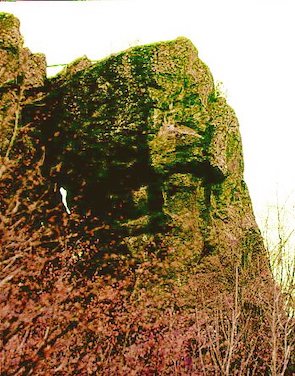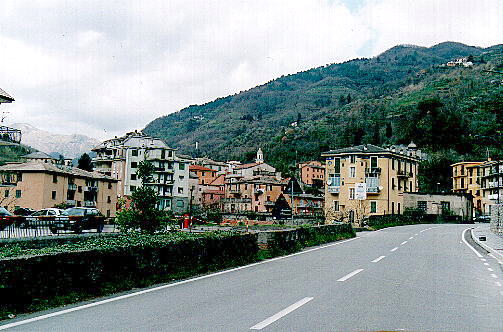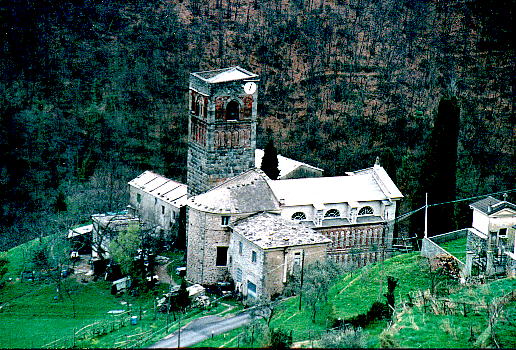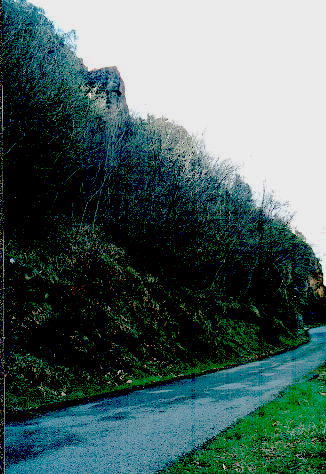

The Megalithic Face of Borzone is located in the middle of a wood of fast growing plants. In the month of June the Mayor of Borzonasca, Mr. Giuseppino Maschio, did a substantial cleaning of the place (i.e. cutting off bushes and trees) so that it is possible to see well the great sculpture, and to replace the sign already put in place some years ago and that unknown vandals had pulled down.
The photos that I present here are the same that can be seen on the site of the Museum of the Origins of Man..
"The great human effigy of the Rocche di Borzone was discovered in January 1965 by Mr. Armando Giuliani, councillor of the Municipality of Borzonasca, during the inspection for the construction of the road. The news was published by the Genoese newspaper Corriere Mercantile on February 1, 1965 by Mr. Luigi Solari. He referred that in Borzone the inhabitants thought that the colossal face was the work of the monks who lived in the monastery annexed to the nearby abbey.

I love legends, just as I loved fairy tales when I was a child.
In the legends, in fact, there are often truths and ideas to do research.
In this case, however, I am disoriented, and I will be grateful to whoever will be able to give me an explanation: how is it possible that a legend so detailed exists, when "the gigantic sculpture was engulfed by the vegetation and forgotten" from several centuries! Especially since it is a historically reliable legend.
In 1975, I and some archaeologist friends became aware of the discovery of the megalithic Face of Borzone, which from the source of that time was defined as "Great effigy of Christ", and finally we went back to the article in the Corriere Mercantile of 1965 with more details.
Our interpretation was immediate, with a shift in attribution from historical times (i.e., from the work of the Monks) to prehistoric times (which then seemed a hazard to many); in fact, when we went to the site, it was immediately apparent that it could not be a recent work, i.e., several centuries old.
Entering into the scientific interpretation I also briefly point out this work in the current cultural context:
1) It has been 35 years that all those who have been interested in the megalithic Face of Borzone have seen a human face in it, and have considered the work as of human workmanship, even if, not being specialists, they have not been able to give it a cultural attribution (that is dating it), but recently the greater part of the observers has considered it prehistoric. And it cannot be other than prehistoric, in how much in Europe, in historical times, the working techniques of the sculpture were much more evolved, and with different subjects of cult.
2) The position of the official science (that one that in the international congresses has the majority of the scholars agreeing) has not still expressed itself about the rock sculpture of the Paleolithic, in how much there are not scholars that have introduced it. For this reason the Paleolithic rock sculpture is absent in the books of history of the prehistoric art with scholastic diffusion.
3) The best known megaliths are menhirs and dolmens, and are large stones erected and planted in the ground. Some menhirs (Carnac, France) are enormous. Some of these are anthropomorphic like the megalithic Face of Borzone. The menhir, except very rare examples, are rough-hewn, that is sculpted to give a harmonious form, or are anthropomorphic or zoomorphic. In the three cases it is art applied to the monument that had purposes of cult.
Menhirs and dolmens, in Western Europe, are generally dated to the 3rd to 2nd millennium BC. Menhirs of this period are usually large, hewed and elongated stones with a harmonious shape. Anthropomorphic menhirs, however, are older, and some are Paleolithic, thus with more than 12,000 years, and this is the opinion of archaeologists who follow the anthropomorphic method. The workmanship technique of the menhir is the same used for the Paleolithic rock sculpture, as the megalithic Face of Borzone. 4) The anthropomorphic menhir and the anthropomorphic rock sculpture have the same subjects of cult that identify themselves with the men that have produced them and that have succeeded in the time: archaic Homo sapiens, Neanderthalians, Homo sapiens sapiens. In substance, in the zones where there were rocks, they carved the rocks, where there were not, the man had to work harder, having to extract the masses from the ground, or to transport them in the places of cult, but the final result was the same.
5) The megalithic Face of Borzone is attributed to the Upper Paleolithic (from approximately 20,000 to 12,000 years ago), as are attributed to this cultural phase many great anthropomorphic menhirs at Carnac. 6) In the Upper Paleolithic in Europe we find very different civilizations from zone to zone, but the two more important are that one of the sculptors of the stone with anthropomorphic subjects of cult, that did not know the painting, and that one of the painters with zoomorphic subjects, that painted in the caves (France, Spain, etc.) and did not sculpt the stone.
The descendants of the peoples with sculpture have founded the cities, invented the agriculture, the breeding of the cattle, the fusion of the metals, etc.. The descendants of the peoples with painting have dispersed around the world living only by hunting and degenerating: Bushmen in Africa, Australian Aborigines, etc.
7) The civilization of the sculptors had more beautiful tools of stone than those of the civilization of the painters. However, the function was the same for the purposes of the daily use.
To say that the painting is better than the sculpture is a mistake, however the colors of the paintings and the images, to the observer of today, generally like mostly.
In common these two civilizations had the dimension of the works, in fact, in the great caves of France and Spain, there are paintings of mammals having the dimensions of the megalithic Face of Borzone. (The dimensions of the Face of Borzone, 7 x 4 m, like already said, are meant only for the face; the other parts that frame it, "hair and a sort of headgear", increase the dimensions).
8) In order to interpret the meaning of the Paleolithic anthropomorphic sculpture, it is necessary to do historical and ethnographic parallelisms with civilizations that have had or still have anthropomorphic sculpture.
Then we realize that the megalithic Face of Borzone was almost certainly a god. Which on the contrary cannot be made with the Paleolithic zoomorphic paintings found in the caves, in how much the parallelisms are not historical, but proto-historical with the extinct populations of the Sahara, and ethnographic with the Bushmen of the South Africa, or the Australian Aborigines, where the zoomorphic representations are connected to "spirits", and not to a deity.
9) In a tourist site, "Tourism Unusual Highway Routes to not always see the usual things", the megalithic Face of Borzone is considered "framed by hair and with a kind of headdress".It is a correct and interesting observation. In the small anthropomorphic sculptures of the Aurignacian (Upper Paleolithic) that now are considered for the greater part work by Homo sapiens neanderthalensis, there is nearly always a pointed headgear (Venus of Savignano, etc.) or a hair well styled (Venus of Willendorf, etc.). These same types of hairstyles are found in ethnography (Africa) with mixtures of various materials. And, always in these Venuses, where are privileged the hairstyles or the pointed headdresses, then the representation of the face, hands and feet is neglected. However, for the scientific investigation, a single case like the megalithic Face of Borzone is not sufficient in order to assert that it is a hair and a headgear, but it is necessary some other rock sculpture (or also mobile) of the same typology, especially since the face is clearly carved, while hair and headgear, they seem it, but it is not sure that they are).
10) In the photograph, the light spot seen on the left of the face is a narrow, high hole through which light has filtered from the back. This can indicate a working of contour of the sculpture, and support the hypothesis of the hair that frames the face.
Nothing we know of the back of the Face. There could be an other image. Like other Paleolithic anthropomorphic sculptures, it could bicephalic. The bifrontism is frequent in the Paleolithic. Once I wanted to visit the back of the sculpture, I have been prevented by the ripidity of the mountain, by the intense vegetation, and above all, by a sudden storm. My curiosity has increased.

12) The more reliable human type of this face is Homo sapiens sapiens. This can be inferred from the high forehead, pointed chin, and relatively narrow face. It has been established recently that in this phase was still present Homo sapiens neanderthalensis, which cohabited with Homo sapiens sapiens, to which it was culturally linked, also for the production of anthropomorphic sculptures, and therefore with similar spiritual and religious practices.
Recently in Portugal have been found the remains of a child that combines the two types of humans. As it is known, Homo sapiens sapiens includes all the humanity of today. In the rock sculpture and in the menhirs of the Paleolithic the representations of Neanderthalians are frequent (and previous), while those of Homo sapiens sapiens are rare. It is possible, therefore, that the megalithic Face of Borzone is one of the more recent works of the Paleolithic.
13) In the Paleolithic anthropomorphic lithic sculpture the frontal representations of the face are rare, those of the head all the way around are very rare. The anthropomorphic sculptures, in the nearly totality, are semifrontal or lateral, and from these it is easier to deduce the evolution of the man, and therefore to date the sculptures of the Paleolithic, making reference to the finds of skulls found in the world, and of which it has been possible a dating with equipments that are not applicable to the lithic sculpture.
The megalithic Face of Borzone is the only rock sculpture known to me today with frontal representation of the face.
14) Who wanted to begin a research on the protohistoric and historical deities of Europe (Celts, Celto-Ligurians, Thracians, etc.) both in the sculptures and in the ceramics, where there are bicephalic and tricephalic representations, will find the beardless god or the bearded god, even if the bearded subjects are a little more frequent. In the Paleolithic lithic sculpture the bearded subjects are rare, and almost all of them do not have beard. However, in the sculpture of the Paleolithic there are parts of the head that are not represented: in the human heads are the ears, in the heads of mammals the ears and the horns.
The megalithic Face of Borzone does not have the beard. Therefore we cannot take for granted that it is a man, it could be the face of a woman.
15) Matriarchy is found in the world today in some of the most primitive cultures. The woman has the same privileges and duties as the man as well as in cultures with patriarchy. In some areas the woman has multiple husbands. The most primitive stages of these cultures have a rough agriculture similar to that one of the European Neolithic (New Age of the Stone).. Nothing we know of the matriarchy in the Paleolithic (Ancient Age of the Stone), but it is possible that somewhere there has been, if still today it survives. If the megalithic Face of Borzone has been work of people of a matriarchal society, if it represents the face of a woman, it could represent a feminine god, that is a goddess.
I CONCLUDE saying that the scientific research in the prehistory needs also of hypothesis, and more there are, better it is; a little like it happens in the investigations of the detectives, in which many clues are added, until the guilty is not discovered.
In the research of the Paleolithic origins of art it is always necessary to try to understand who was the man who produced a determined type of art, and why he did it. An analysis based on the only aesthetic values is not useful to the understanding. Very useful is instead the comparison of opinions. So, I am at disposal of the readers for eventual further explanations, and also waiting for their opinions. Among these: DO THEY CONSIDER the megalithic Face of Borzone THE FACE OF A MAN OR THAT OF A WOMAN?
Copyright©2000-2002 by Paleolithic Art Magazine, all rights reserved